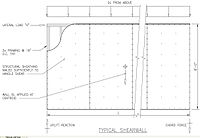
Photo from wikipedia
Abstract Tall buildings have unique seismic challenges, particularly the P-delta effect. This can cause an increase in loads on certain parts of the structure, leading to potential instability or collapse.… Click to show full abstract
Abstract Tall buildings have unique seismic challenges, particularly the P-delta effect. This can cause an increase in loads on certain parts of the structure, leading to potential instability or collapse. The solution is to use buckling restrained bracing (BRB) systems, which improve the lateral strength of the structure and control the P-delta effect. The present study aimed to determine the effectiveness of various brace configurations in reducing the seismic response of a 50-story reinforced concrete structure, with a focus on P-delta effects. To achieve this, linear dynamic analysis (response spectrum analysis) was conducted using E-TAB software. The selection of bracing configuration, however, depends upon the seismic zone. For this reason, five distinct configurations (X-pattern, inverted V, forward inclined, zig-zag, and bare frame) are considered for the analysis of buildings in different seismic zones. A building model was employed to study the behaviour of a structure with and without BRB to compare the parameters of storey drift, story displacement, diaphragm drift, story shear, story stiffness, and story acceleration using E-TAB software. Results showed that both Type-4 and Type-2 braces perform similarly in several aspects in seismic zones III and V. However, Type-2 braces perform slightly better in terms of storey stiffness-Y, with a lower difference of 39-40 % compared to Type-4 braces with a difference of 49 %.
Journal Title: Civil and Environmental Engineering
Year Published: 2023
Link to full text (if available)
Share on Social Media: Sign Up to like & get
recommendations!